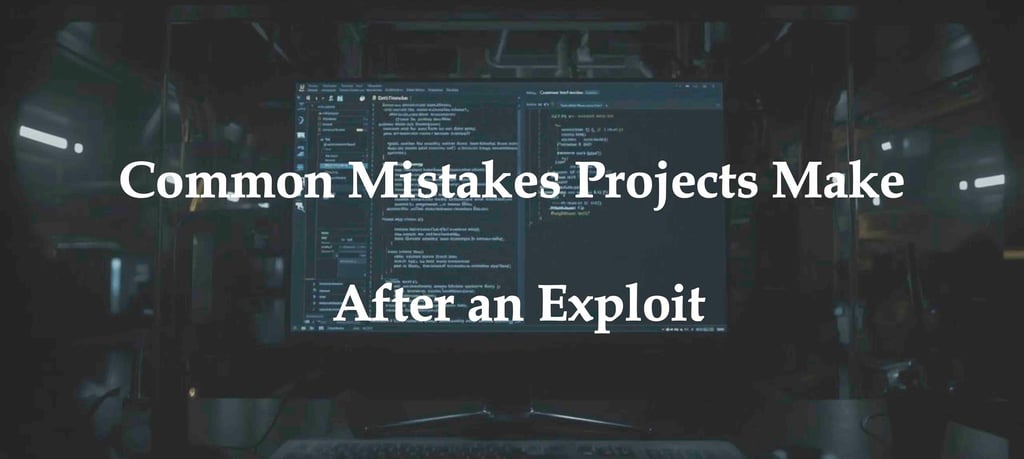Common Mistakes Projects Make After an Exploit
Projects often neglect security despite investing heavily in platform development, leaving them vulnerable to attacks. Recovery success depends on swift, comprehensive responses. However, many projects make critical post-exploit mistakes. In this article, we will explore the most common mistakes projects make after an exploit and how to avoid them.
CRYPTOCURRENCY INVESTIGATIONDIGITAL ASSET CRIME
Gracious Igwe
7/4/20254 min read


▶Introduction
Projects invest significant resources into building robust platforms, but may often neglect the security aspect, leaving them vulnerable to attacks. The outcome of such incidents can determine whether a project recovers and continues to thrive or faces a prolonged struggle to regain its reputation and user trust.
The key to recovery is a swift, measured, and comprehensive response. Unfortunately, many projects make mistakes in the aftermath of an exploit that can jeopardize their ability to recover fully. These errors range from delayed responses and failure to engage experts to neglecting long-term security strategies and insufficient community communication.
In this article, we will explore the most common mistakes projects make after an exploit and how to avoid them.
Image generated via Leonardo.ai
1. Delayed Response:
When an exploit occurs, every moment counts. Attackers waste no time in moving stolen assets through mixers, cross-chain bridges, or privacy-focused tokens to obscure their trail. Any hesitation from the affected project can give these actors the upper hand, making it much more difficult to track or recover the funds. Whether it’s a failure to freeze compromised accounts, a delay in pausing smart contracts, or a reluctance to notify stakeholders and engage law enforcement or blockchain investigators, every minute of inaction widens the attacker’s window of opportunity. These delays not only diminish the chances of asset recovery but also increase the risk of further reputational damage and community distrust.
How to Avoid This Mistake:
Activate a Predefined Incident Response Protocol: Projects should have a predefined incident response plan for such incidents. This should include immediate actions like freezing accounts, locking smart contracts, and restricting access to critical systems.
Track the Movement of Funds: Using blockchain intelligence tools, start tracking the stolen funds immediately. This allows you to follow the hacker’s actions and gain insights into where the funds might be moved.
Notify Stakeholders Early: Transparent communication with stakeholders, i.e, users, investors, and partners, is essential. Providing timely information helps protect them from further exposure to risk.
▶Conclusion
The aftermath of a security exploit can determine a project's survival. The four common mistakes— delayed response, lack of expert involvement, absence of post-incident security planning, and poor communication—are entirely preventable with proper preparation. Effective recovery requires swift action, expert engagement, and transparent communication. Projects must immediately activate incident response protocols, involve blockchain forensics specialists, and maintain open dialogue with their community. Beyond the immediate response, implementing robust security frameworks and conducting thorough post-incident audits are essential for preventing future attacks.
If you need help from expert to build stronger protection, lowering the probability of facing the risk, Chainvestigate provide varies services and feel free to contact us.
2. Lack of Expert Involvement:
In the heat of the moment, some projects attempt to manage the effects of the exploit on their own. While it is understandable that teams may want to handle the situation internally, this is a common mistake. The complexity of most exploits makes it difficult for internal teams without specialized knowledge to investigate effectively. In-house teams may lack the tools or expertise to trace complex transactions or uncover hidden vulnerabilities, which can prolong the recovery process or lead to ineffective responses.
How to Avoid This Mistake:
Engage Blockchain Forensics Experts: As soon as an exploit occurs, reach out to experts who can trace stolen funds, analyze on-chain data, and uncover hidden patterns in the exploit. Investigation firms like Chainvestigate have advanced tools to help identify transactions across multiple blockchains. With our in-depth analysis, projects can confidently follow the trail of funds, pinpointing the hacker's steps across multiple chains and increasing the likelihood of recovery.
Collaborate with Law Enforcement: In most cases, involving law enforcement early can help with the legal aspects of recovering funds and possibly identifying the attackers.
3. No Post-Incident Security Plan:
Once the immediate threat has been mitigated, projects must turn their attention to preventing future exploits. Neglecting to conduct a thorough post-incident security audit and implement a long-term security plan can result in repeated attacks. Without a detailed post-incident audit, the same weak points can be exploited again in the future.
How to Avoid This Mistake:
Conduct Thorough Post-Incident Audit and Tests: Perform a deep dive into the systems involved in the breach, including auditing smart contracts, testing user interfaces, and other critical components. A comprehensive audit ensures that the root cause of the exploit is identified and remedied.
Strengthen Security Protocols: In addition to addressing the immediate vulnerabilities, projects should enhance their overall security framework. This includes implementing more robust monitoring systems, conducting regular security reviews, and upgrading key security protocols.
Educate the Team on Security Best Practices: Building a security-conscious team is crucial for maintaining the integrity of your project. Regular security awareness training should be mandatory for all team members.
4. Communication and Community Engagement:
After an incident, community trust is one of the most valuable assets a project can rebuild. Without transparency and engagement, users and investors may lose confidence in the platform, and the project’s future could be in jeopardy.
Silence or inadequate communication can give the impression that the project is hiding something or is not fully committed to resolving the issue.
How to Avoid This Mistake:
Provide Clear and Regular Updates: Keep the community informed about the status of the recovery, the steps being taken to improve security, and any compensation for affected users. Regular communication fosters trust and shows that the project is actively addressing the problem.
Address Community Concerns: Engage with the community to listen to their concerns and provide responses promptly. Ignoring or dismissing user concerns can further damage the project's credibility.

